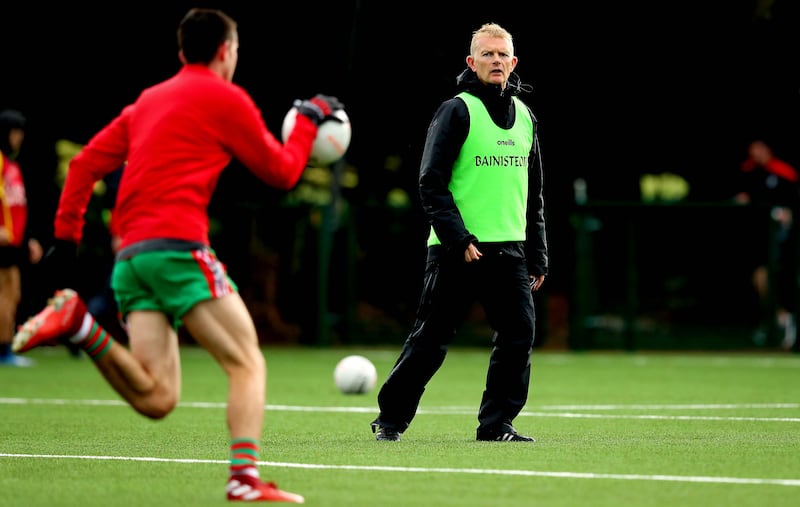All marathon journeys are about reaching your destination: the finish! In the fourth of our monthly series, The Irish Times continues its running lessons to help make that journey a little easier and a lot more fun – right to the finish of the 2023 Irish Life Dublin Marathon on October 29th.
Part 1: No other sporting event delights in the long countdown more than this classic distance
Part 2: Why you should get into the habit of doing morning runs
READ MORE
Only 150 days to go! That gentle reminder popped up somewhere during the week, which may or may not ring some warning bells. Either way it’s time to get a little more serious about the things that matter in the long run.
So no harm calling on one of the trained experts. As said here from the outset, it doesn’t matter if you’re a marathon virgin or a marathon veteran, running for the first time or (you think) the last time, the same guiding principles apply.
Which is the first thing Brendan Hackett tells me too, and he needs to know what he’s talking about, because he is the coaching expert for this year’s Irish Life Dublin Marathon, with the role of supporting the full range of runners on their journey to the start line.
We go back a bit and used to share some very long runs in the Dublin Mountains before gravity warned us off: Hackett has coached several elite Irish runners over the years, including James Nolan and Maria Lynch, and has also served his time coaching Gaelic football, including senior inter-county roles with Longford, Offaly and Westmeath, and more recently he managed Ballymun to the Dublin title.
It helps, naturally, that Hackett has also run several marathons – including Boston, New York and London – and is well trained in sports psychology too.
“For any running purposes, particularly the marathon, the first thing to do is break the body into two parts,” he says. “The framework, as in the bones and the attachments, and then the engine, as in the heart and the respiratory system.
“The biggest pitfall at this early stage is stressing the framework too much or too soon and getting injured. So to avoid that, the most important thing is getting the frame used to running, by slowly increasing and adding miles.”
Hackett, like me, still talks in old money, as in miles, so metric-lovers beware: “So these next few months are about gradually building up the stress on the framework, by gradually increasing the mileage.
“There is the 10 per cent rule of thumb. If you take week one, then the overall for week two, no one run should increase by no more than 10 per cent, and likewise, the weekly mileage total should not increase by more than 10 per cent.
“It’s not linear either. After every three weeks, if you’ve been increasing to 45 miles, or 50 miles, for the fourth week, take a step back, drop back to week two, which gives the body the chance to recover, and advance. And all the while the framework is building strength, and the engine is also starting to adjust with it.”
Hackett has designed many individual marathon training plans over the years and all stress the importance of keeping a training diary.

“The important thing here is to have some sort of schedule. So, the same way you would make an appointment with the dentist, make an appointment to run. It could be the morning or the evening, the shorter runs during the week, the longer runs as the weekend.
“For the novice, starting out, it might be three days a week, working up to four or five. And don’t underestimate walking. If you are only running three days a week, then take in one or two days for a long walk.
“The novice marathon runner will likely be out there for around four hours, that’s a long time on your feet. If you can run for an hour at this stage, no harm adding a half-hour walk afterwards, so you’re getting used to being out there for 90 minutes, and that’s psychological preparation too.
“And at this stage you should mostly be running at what I call it singing pace. Where you could sing a song, if you wanted to, the pace should be that comfortable. At least keep it at conversation pace – don’t drift too far off it. If you’re at the stage you can’t hold a conversation, you’re running too fast.”
This by the way is the same advice Hackett gives to one of his athletes, Martin Hoare, who was the first Irish finisher in last year’s Dublin Marathon, running a lifetime best of 2:20:21, at age 35. The Kildare runner aims to go faster again this year.
“Those same guiding principles apply if I’m coaching Martin or an absolute beginner, so there’s no reason to end up injured, or too sore. There will be some setbacks, but stick to the plan, the plan will stick by you.”
DO
Invest in plenty of proper running socks. This is good advice too from Hackett, and perhaps not as obvious as it sounds.
“There is no doubt the super-shoes, or this revolution in shoe technology, has taken a huge amount of impact off the framework, while also improving running efficiency, and recovery.
“So invest, if you haven’t invested already. That €150, €200 might feel like a heavy outlet, but one visit to the physio will quickly cancel it out.
“And the same goes for a good pair of running socks. They’re going to cost you that bit more, but I have a motto: the bitterness of bad quality will last longer than the sweetness of a cheap price. So go for sock quality, not cheap quantity.”
Hackett has another one on his ‘do’ list: “That’s having a running partner, some person to run with. They don’t have to be the same level. There will always be that day you don’t want to run, but with a partner, or a small group, you’re more inclined to get out. It invariably makes it more enjoyable too.
DON’T
Forget the four Rs – as in Rehydration, Refuel, Reduction and Rest.
These are among the guiding principles Hackett has for all levels of marathon runners. The rehydration part is perhaps most obvious, that need to keep sipping on water before running, then a sports specific drink afterwards.
The refuelling is sometimes overlooked, the need to get some food on board as quickly as possible, particularly after a long run. By reduction he means muscle damage, so some gentle stretching will always go a long way, as, he says, will some cold-water immersion.
“It doesn’t have to be a full-on ice bath, but if you can get into the sea, or a dip in the lake once or twice a week, it’s a huge physical and psychological benefit in calming the muscle tissue down.
Don’t underestimate the resting part either, or the need to sometimes cut back.
“With Martin Hoare, he was thinking I need to be at 80, 90 miles a week. But he’s working, has young kids, running 80, 90 miles a week is just going to stress your whole system. So we dropped it back to 60, 65, that’s when the injuries stopped, and he started running better.”
TARGETS
These are ready-made right now in the form of the Irish Life Dublin Marathon race series, which, as Hackett points out, are perfect in establishing your expected marathon finishing time.
These runs start with the Corkagh Park 5 Mile on June 18th; then the Fingal 10km on July 16th; then the Frank Duffy 10 Mile on August 19th; finally the Half Marathon on September 23rd.
“Each one is essentially spaced a month apart, so they are ideally timed to stay on a target, keep track of where you are, or where you need to be going. Certainly after the half-marathon in September you will have a fair idea of what you target finish time should be.”
And what about having a running coach?
“The big advantage is the feedback. The novice is probably following some programme blindly, and just because the programme says you need to run 10 miles today, they go out and run 10 miles. A coach might say, ‘you look tired today, go for five miles instead, or go for a walk’.”
And take it from me, that’s good advice.
















